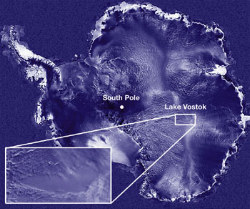What's happening in exploration
Exploring Lake VostokFor many years, Lake Vostok has held this editor’s fascination with exotic and remote exploration. Progress on the project has been intentionally slow and cautious; the last newsworthy event was the announcement that analysis of the Vostok ice core – the world’s longest – showed atmospheric CO2 and methane levels are higher now than at any time during the last 420,000 years. For the benefit of those unaware, a brief history seems in order. Vostok station was established in the late 1950s near the south geomagnetic pole, partly to give Russia an Antarctic presence during the Cold War. The Russians began drilling the famous ice core in the late ’70s, the French joined them in the early ’80s and the Americans became partners in 1989. Lake Vostok was first identified by airborne radar (which can penetrate ice) in 1974. Back then, nobody realized its breadth, depth or significance. However, that changed in 1991, when remote-sensing specialist Jeff Ridley used Europe’s ERS-1 satellite to view the ice-trapped lake. That data, when combined with earlier seismic and airborne radar, revealed the startling truth: a massive body of water more than 150 mi long and 30 mi wide, with water depths more than 1,600 ft deep, buried beneath 13,000 ft of ice and isolated for 35 million years. The full impact of the discovery slowly dawned on the ice-core drilling team, and, after much discussion, drilling was halted at 11,800 ft – about 400 ft above the lake.
Today, a debate ensues: How does one penetrate and sample an alien world that has been isolated for 35 million years – without contaminating it? You don’t want to "discover" something that you accidentally introduced, nor contaminate – possibly forever – that which you are trying to sample. Two new factors have emerged that give the question added impetus. First, recent evidence from the Galileo spacecraft orbiting Jupiter has revealed what most likely are ice-covered, liquid-water oceans on Europa, one of Jupiter’s moons. Second, the Antarctica and Southern Ocean Coalition (ASOC) wants to postpone drilling Vostok – indefinitely. Europa has become the leading candidate for finding life beyond Earth. NASA wants to use Lake Vostok as a test bed for future missions to Europa, the first of which is an orbiter scheduled for launch in 2003–2004, so its timetable is tight. A subsequent mission, if Europa’s oceans are confirmed, involves launching a probe that would bore through the moon’s icy surface and sample the water beneath. The parallels to Vostok are obvious. Geologists and biologists are also anxious to get at the lake. It may contain unknown life forms, and its undisturbed sediments may reveal facets of Earth’s tectonic and climatic history. The technology currently under development to explore these frozen netherworlds is complex. Envisioned is a hot-water drilling system that would inch a probe closer to the lake. The borehole would freeze behind it as the probe pays out more cable. Then, some form of chemical sterilization would bathe the probe just before entering the lake. All of this would be accomplished in a cylindrical package perhaps 1 in. dia. by 3 ft long. Since 1991, the Madrid Protocol to the Antarctic Treaty prohibits mining activity, including hydrocarbon exploration, until the year 2041. ASOC, a coalition of 240 nongovernmental organizations from 50 countries, intends to issue a resolution that would postpone drilling Lake Vostok indefinitely. Although an ASOC resolution isn’t binding, the Antarctic Treaty allows groups such as ASOC to file lawsuits. This project will likely be an ongoing battle between the forces of the "pristine" – represented by ASOC, and the scientific community – comprising NASA, Woods Hole, JPL Polar Oceanography Group, National Science Foundation and numerous other institutions throughout the world. Everyone wants to see Lake Vostok’s pristine state preserved, but to leave it untouched – for its own sake – makes no sense, especially when there is so much potential for discovery. Let’s hope the explorationists win this one. New Zealand successes. Swift Energy Co. and partners announced a discovery in Rimu field, about 185 mi SW of Auckland. Well A1 tested 1,500 bopd and 5 MMcfgd. The company believes it is near the edge of the field, which could contain 100 million bbl of oil. Another nearby prospect, the Kauri structure, might contain as much as 500 million bbl if it is oil-filled. Of course, only the drill bit will tell for certain; the partners plan to drill two delineation wells in Rimu starting at midyear, followed by a test of the Kauri structure. In a separate venture, Fletcher Challenge Ltd., as operator for a consortium, tested its Pohokura-1 exploration well. Located 3 mi off the North Taranaki coast, the well is targeting gas condensate in the Kapuni sands group. The first test flowed 3.4 MMcfg and 160 bbl condensate per day, on a 46/64-in. choke, from a zone between 11,894 and 11,923 ft. A second test between 11,657 and 11,713 ft produced 17.0 MMcfgd through a 54/64-in. choke. Reserves are estimated at 200 to 500 Bcfg. These are huge fields by New Zealand standards (if reserve
estimates hold).
|




